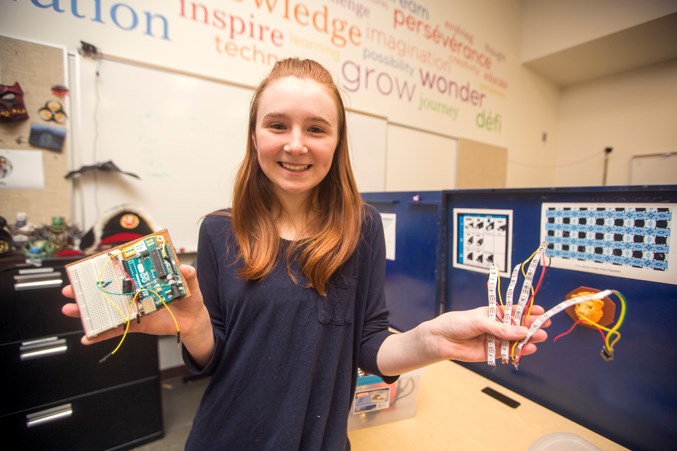CANMORE – From a video game where the player is a bear preparing for hibernation to a utility box turned into an artful fundraiser, students at Lawrence Grassi Middle School didn’t shy away from a self-directed project assigned by their Grade 8 teachers this semester.
Sage Jonker, for example, wrapped a utility box in a vinyl canvas featuring an image of mountains, springing the otherwise plain eyesore into life in a way that only art can. Jonker created the image on Photoshop and within it has strategically, and creatively, hidden six animals that can be found in the Rocky Mountains. The artwork itself is all a part of a much bigger project that the young, talented teen has taken on.
“It’s a 50/50 draw, so when you find an animal in my image you can donate a certain amount of money and that kind of decides how many entries you get into the 50/50 draw,” said Jonker. “Half the money will go to the winner and the other half will go to an organization called the Universal Outreach Foundation.”
This particular foundation builds schools in Liberia and Jonker said she chose it because she felt education was connected to art.
Jonker’s entire project started in her Grade 8 class at Lawrence Grassi Middle School. Students were given time each day to work on a personal project, an idea that she said sprang from Google’s 20 per cent Project that resulted in products like Gmail and Google News.
Jonker’s teacher, Rob Boyd, said the project is an innovative way for students to learn.
“We sat down and looked at this idea of passion projects in school,” he said. “So much of school is directed learning where teachers are telling students what to do, how to do it and what the goal was … We were wondering what would happen if students were the designers of their own learning.”
Boyd said the assignment had mixed results, but many students leaped at the chance to explore their personal passions.
Colin Fearing and Jonah Holthuis for example, jumped right into game design. Fearing created a video game that illustrates resource management using a bear that prepares for hibernation.
“I wanted to educate the community about why our native wildlife comes into town,” Fearing said. “Everything the player does uses precious energy. Exploring helps you find more food and possibly a den to hibernate but also uses energy.”
Holthuis created a first-player game where the player has to dodge shapes on a quickly moving screen.
“I was always fascinated by computer programming so I thought I’d give it a go,” said Holthuis. “It took me probably four months to do. Probably the hardest part was figuring out how it all works.”
Rien Solodan was inspired by the innovative ways other countries recycled.
“I learned that in some countries, people can use empty cans and bottles to pay for bus tickets. After searching more, I found these machines that actually load the funds onto cards like a debit card and use them to buy things like movie tickets,” she said.
Solodan said she researched artificial intelligence to create a machine that encourages people to recycle.
“I found out more empty bottles and cans are thrown out than recycled,” she said. “I thought if there were more machines like this, people would be more motivated to recycle as they would be instantly rewarded.”
Boyd said the students picked all levels of challenging tasks to take on.
“My class has 23 students and the projects went everything from learning Mandarin to animation, to charity work, to soldering and electronics projects, to computer programing and robotic projects,” he said.
Sierra Bramble wanted to maintain contact with exchange students from China so began learning Mandarin. Liann Sigua, drew and wrote a manga graphic novel. Avery Bennett began the process of making an LED suit with the hopes her sister would eventually dance in it. Emma Salter wanted to follow in her grandmother and aunts footsteps with homemade jewelry.
All the students were expected to create a blog and document their progress and many hit a few snags along the way. Boyd said Paul Fearing was instrumental in helping the students get from A to B with their projects. Paul has helped build a “Chaos Room,” which is a room at LGMS where students are encouraged to create, and can use things like a 3D printer, or a virtual reality set.
“He sort of built this maker space as a pure volunteer endeavour so he’s coming in, he’s here every single day for as many hours as the teachers,” said Boyd.
“Over the last couple of years I’ve basically tried to build this room and have resources to allow projects like the 20 per cent Time,” said Paul.
All in all, Boyd said he was fairly impressed with the initiative the students took and that he hopes to foster in them the idea that they can do anything.
“What we’re trying to push is that fixed mindset of operating within well defined tasks that are defined by somebody else into that growth mindset,” he said. “Ideally turn them into lifelong learners, so when they see something it’s not ‘oh that’s cool, I wish I could do that,’ it’s ‘oh that’s cool, I think I can do that.’ ”
You can see some of the projects as well as make some of your own at Mountain Maker Madness on June 7, which will showcase CRPS builders, creators and makers. More information about this event and the student projects is available at www.mountianmakermadness.com.




